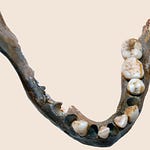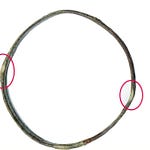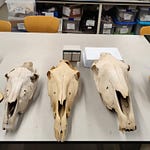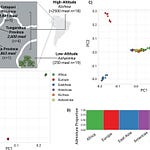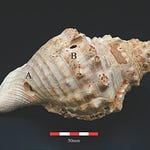At a limestone rock shelter called Riparo Tagliente in northern Italy, a young man's remains have been whispering a violent story for decades. His partial skeleton, discovered in 1973 and dating to roughly 17,000 years ago, had long intrigued archaeologists for its ceremonial burial. But the cause of his death remained speculative—until now.
In a recent reanalysis published in Scientific Reports1, bioarchaeologists used high-resolution 3D microscopy and scanning electron microscopy (SEM) to examine deep incisions in the man's femur and tibia. What they found offers one of the earliest, most direct pieces of evidence for lethal intergroup conflict during the Late Upper Paleolithic.
A Hidden History in Bone
Tagliente 1, as the individual is known, lived in the Lessini Mountains during the Late Epigravettian period, a time when humans were recolonizing the southern Alpine region after the Last Glacial Maximum. His burial had all the hallmarks of ritual: a shallow grave, engraved stones, ochre-stained pebbles, and a pierced shell. But it is his injuries that tell a darker story.

Microscopic analysis of the incisions on his femur and tibia revealed that they were not post-mortem damage, nor the result of animal gnawing, nor marks of ritual defleshing. These were projectile impact marks (PIMs), consistent with wounds caused by flint-tipped weapons launched at high speed.
"These wounds could not have been caused by butchery or trampling. Their shape, depth, and microstriations are entirely consistent with experimental data on projectile trauma," noted the study's lead bioarchaeologist.
The most telling detail? The orientation of the wounds. One projectile struck the front of his thigh, from above. Another entered from behind his lower leg. The pattern suggests he was either fleeing or ambushed by attackers from multiple directions.
The Paleolithic Politics of Violence
Interpersonal violence among Paleolithic humans is notoriously difficult to identify. Unlike mass graves or embedded weapons, skeletal evidence from this period is sparse and fragmentary. Yet projectile weapons—arrows, darts, or spears—require a certain level of planning and distance, making them ideal for ambushes or skirmishes between groups.
Tagliente 1's wounds fit this context. The projectiles appear to have come from different angles, and the lack of healing indicates he died almost immediately. One of the femoral wounds lay perilously close to the main artery, suggesting a quick and fatal hemorrhage.
"The trauma pattern supports the hypothesis of intergroup aggression rather than accidental injury or internal dispute," said one of the authors. "This is not a personal duel. This is something more coordinated."
A Prehistoric Cold War?
The Late Epigravettian period was one of ecological transition. As glaciers retreated, human populations expanded into new territory. In this patchwork of newly available land, groups may have come into closer contact, competing for game, water, or raw materials. Resource stress could easily have sparked hostilities.
But conflict wasn’t just about survival. In mobile forager societies, violence may also have been performative—a way to assert dominance, defend territory, or prevent encroachment.
"We tend to idealize hunter-gatherers as peaceful egalitarians," remarked one prehistoric anthropologist unaffiliated with the study. "Finds like this disrupt that narrative and remind us that lethal violence has deep roots."
A Dignified Death After a Violent End
Despite the violence, the burial of Tagliente 1 was careful and ceremonial. Large engraved stones covered his legs. He was interred supine, with arms extended, as was customary. The presence of symbolic objects—ochre pebbles, a pierced shell, and a bovid horn—suggests he was mourned.
This juxtaposition of violence and ritual care hints at the social significance of his death. Perhaps he was seen as a victim of honor, or perhaps his death threatened the cohesion of his group and required ritual containment.
Conclusion
The case of Tagliente 1 challenges long-held assumptions about the origins of violence. It reminds archaeologists that for every Paleolithic handprint on a cave wall or carved animal figurine, there might be a wound carved in bone—a less visible but no less telling artifact of human behavior.
"This burial is not just a data point. It's a story of conflict, loss, and memory written in the body of a young man," one researcher reflected. "And it's a story we are only beginning to read."
Related Studies
Churchill, S. E., et al. (2009). Shanidar 3 Neandertal rib puncture wound and Paleolithic weaponry. Journal of Human Evolution, 57(2), 163–178. https://doi.org/10.1016/j.jhevol.2009.05.010
Crevecoeur, I., et al. (2021). New insights on interpersonal violence in the Late Pleistocene based on the Nile valley cemetery of Jebel Sahaba. Scientific Reports, 11, 9991. https://doi.org/10.1038/s41598-021-89386-y
Duches, R., et al. (2016). Identification of Late Epigravettian hunting injuries: Descriptive and 3D analysis of experimental projectile impact marks on bone. Journal of Archaeological Science, 66, 88–102. https://doi.org/10.1016/j.jas.2016.01.005
Sparacello, V. S., Thun Hohenstein, U., Boschin, F., Crezzini, J., Guerreschi, A., & Fontana, F. (2025). Projectile weapon injuries in the Riparo Tagliente burial (Veneto, Italy) provide early evidence of Late Upper Paleolithic intergroup conflict. Scientific Reports, 15(1), 14857. https://doi.org/10.1038/s41598-025-94095-x


